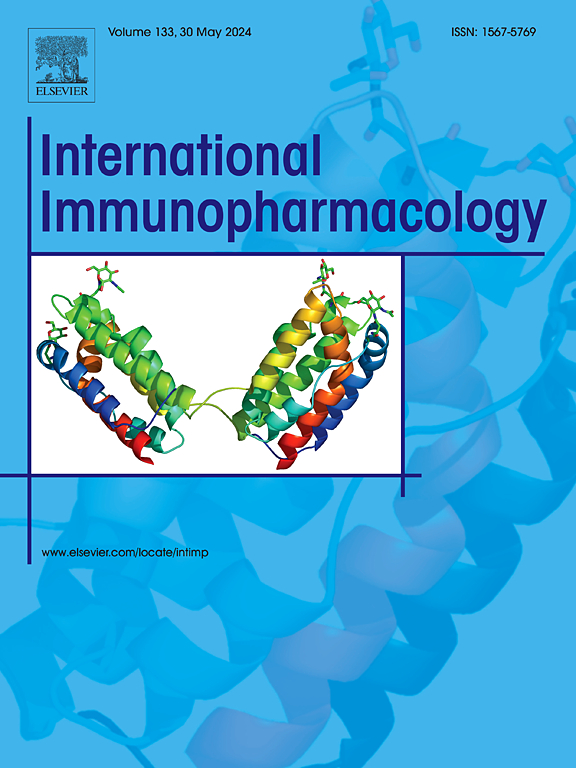GTS-21 alleviates sepsis-induced atrial fibrillation susceptibility by modulating macrophage polarization and Neuregulin-1 secretion
IF 4.8
2区 医学
Q2 IMMUNOLOGY
引用次数: 0
Abstract
Objective
Sepsis-induced atrial fibrillation (AF) is driven by systemic inflammation and macrophage-mediated atrial remodeling, with proinflammatory M1 macrophages playing a key role. This study investigates whether GTS-21, an α7nAChR agonist, can reduce AF susceptibility by promoting macrophage polarization towards the anti-inflammatory M2 phenotype.
Methods
A mouse model of lipopolysaccharide (LPS) (10 mg/kg)-induced sepsis was used to explore the relationship between atrial inflammation and AF. GTS-21 (20 mg/kg) was administered to assess its impact on 48-h survival and AF incidence. Cardiac function was evaluated using echocardiography. Markers of myocardial injury, including CK-MB, LDH, and cTnI, were measured. Macrophage polarization and atrial inflammation were assessed using immunofluorescence, flow cytometry, RT-qPCR, and western blotting. Oxidative stress and mitochondrial function were evaluated using reactive oxygen species (ROS) measurements, electron microscopy, and mitochondrial protein expression analysis. Calcium dynamics were studied using western blotting and confocal microscopy.
Results
In LPS-induced septic mice, GTS-21 improved 48-h survival rates and reduced the induction rate and duration of AF (P < 0.05). Echocardiography showed a preserved left ventricular ejection fraction and enhanced diastolic function. Mechanistically, it promoted M2 macrophage polarization, inhibited the NF-κB P65/NLRP3/C-caspase 1 pathway to reduce IL-1β release, and alleviated oxidative stress. Additionally, mitochondrial structure was restored by reversing fission and promoting fusion, while calcium-handling proteins (NCX-1, RYR2, and SERCA2a) were regulated to prevent intracellular calcium overload, reducing AF susceptibility.
Conclusion
GTS-21 mitigated atrial inflammation and reduced the incidence of AF in mice with sepsis by regulating macrophage polarization, reducing oxidative stress, and preserving mitochondrial and calcium dynamics in cardiomyocytes. These findings highlight the therapeutic potential of GTS-21 in treating sepsis-induced AF.
GTS-21 通过调节巨噬细胞极化和 Neuregulin-1 的分泌,减轻脓毒症诱发的心房颤动易感性
本文章由计算机程序翻译,如有差异,请以英文原文为准。
求助全文
约1分钟内获得全文
求助全文
来源期刊
CiteScore
8.40
自引率
3.60%
发文量
935
审稿时长
53 days
期刊介绍:
International Immunopharmacology is the primary vehicle for the publication of original research papers pertinent to the overlapping areas of immunology, pharmacology, cytokine biology, immunotherapy, immunopathology and immunotoxicology. Review articles that encompass these subjects are also welcome.
The subject material appropriate for submission includes:
• Clinical studies employing immunotherapy of any type including the use of: bacterial and chemical agents; thymic hormones, interferon, lymphokines, etc., in transplantation and diseases such as cancer, immunodeficiency, chronic infection and allergic, inflammatory or autoimmune disorders.
• Studies on the mechanisms of action of these agents for specific parameters of immune competence as well as the overall clinical state.
• Pre-clinical animal studies and in vitro studies on mechanisms of action with immunopotentiators, immunomodulators, immunoadjuvants and other pharmacological agents active on cells participating in immune or allergic responses.
• Pharmacological compounds, microbial products and toxicological agents that affect the lymphoid system, and their mechanisms of action.
• Agents that activate genes or modify transcription and translation within the immune response.
• Substances activated, generated, or released through immunologic or related pathways that are pharmacologically active.
• Production, function and regulation of cytokines and their receptors.
• Classical pharmacological studies on the effects of chemokines and bioactive factors released during immunological reactions.

 求助内容:
求助内容: 应助结果提醒方式:
应助结果提醒方式:


